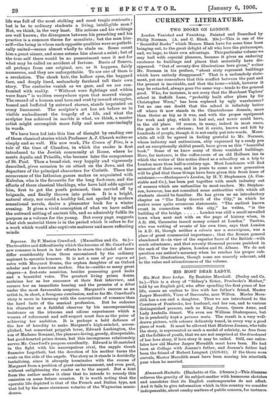CURRENT LITERATURE.
TWO BOOKS ON LONDON.
London Vanished and Vanishing. Painted and Described by Philip Norman. (A. and C. Black. 20s.)—This is one of the "Beautiful Books" which Messrs. Black have for some time been bringing out, to the great delight of all who love the picturesque, and, we hope, to their own advantage. This particular volume we may hail with especial pleasure, because it gives an enduring existence to buildings and places that materially have dis- appeared. "Out of seventy-five illustrations here given," writes Mr. Norman in his preface, " about sixty represent buildings which have entirely disappeared." That is a melancholy state- ment, yet one remembers that this conflict between the past and the present is inevitable, and that the issue—which, however it may be retarded, always goes the same way—tends to the general good. Who, for instance, is not sorry that the Merchant Taylors' school in Suffolk Lane, "probably built after plans by Sir Christopher Wren," has been replaced by ugly warehouses? Yet no one can doubt that the school is infinitely better off where it now stands in the Charterhouse domain, more than thrice as big as it was, and with the proper equipment for work and play, which it had not, and never could have, in the old place. Of course, in many, indeed in most cases, the gain is not so obvious ; but it exists, known and felt by hundreds of people, though it is not easily put into words. Mean- while all will be agreed in feeling grateful to Mr. Norman, whose industry and enthusiasm, ably expressed by a ready pen and an exceptionally skilful pencil, have given us this "beautiful book." Some of us knew many of these vanished buildings. Here, for instance, is the coffee-room of an old Holborn inn in which the writer of this notice dined as a schoolboy on a trip to London more than half-a-century ago. Most Londoners will find memories of their own, and in years to come a new generation will be glad that these things have been given this fresh lease of existence.—Shakespeare's London, by H. T. Stephenson (A. Con- stable and Co.), has been put together with much industry out of sources which are unfamiliar to most readers. Mr. Stephen- son, however, has not consulted some authorities with which all students should be familiar. He has given us an introductory chapter on "The Early Growth of the City," in which he makes some quite erroneous statements. "The earliest known event in connection with the city," he writes, "is the building of the bridge London was still a small unwalled town when next met with on the page of history when, in A.R. 286, Caransius issued money coined at London." Tacitus, who was writing of events of his own time, says that London in A.D. 61, though neither a colonia nor a municipium, was a place of great commercial importance ; that the Roman general abandoned it—in view of the superior force of the British—with much reluctance; and that seventy thousand persons perished in the sack of the two places, London and St. Albans. We do not question our author's accuracy when he reaches his proper sub- ject. The illustrations, though some are scarcely relevant, add to the value and attractiveness of the volume.


















































 Previous page
Previous page